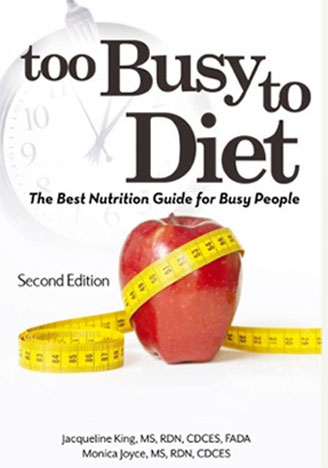Diabetes Corner: Back to Basics
in The Too Busy to Diet Blog on March 17, 2014
Written by Teri R Belisle, PharmD, RD, LDN.
If you have Type 1 or Type 2 diabetes, no matter if you take insulin or oral medications, keeping track of your carbohydrate intake is probably a big part of your daily routine. Since carbohydrates raise blood sugar levels the most, compared to fats and proteins, being able to recognize these foods is the first step in managing your blood sugar. The food groups that contain carbohydrates, and therefore will raise your blood sugar the greatest and most quickly, are:
1. Starches and Starchy Vegetables (potatoes, pasta, rice, breads, corn, peas, etc.)
2. Fruits (bananas, melon, apples, oranges, grapes, etc.)
3. Milk and Yogurt (cow’s milk, soy milk, ice cream, yogurt)
It is important to know that one “carb serving” contains about 15 grams of carbohydrate, and one “carb serving” of any carbohydrate food will raise the blood sugar the same amount. The tricky part is that different portions of different foods equals one “carb serving”, and remembering all the portion sizes can become very confusing.
So how is one to keep track of the carbohydrates they are consuming with each meal or snack? Some simple tools can help make “carb counting” a little less confusing and a lot more accurate. First keep handy a list of carbohydrate foods which indicates the portion size that is equal to one “carb serving” or 15 grams of carbohydrate. Copy and paste the following link in your web browser for a helpful list:
http://iuhealth.org/images/ril-doc-upl/Carbohydrate%20Counting%20Food%20List.pdf
Second, always use measuring cups to portion out your carbohydrate foods. Third, read nutrition labels when available.
For example, keeping a carbohydrate food list handy can help you quickly identify that 1/2 cup of mashed potatoes is equal to one “carb serving”. Using your measuring cup you can accurately portion out 1/2 cup of mashed potatoes and be confident that you are consuming 15 grams of carbohydrate. Regularly using measuring cups can help prevent errors in estimating portions which could have a negative impact on your blood sugar.
If you have a food that tends to vary in carbohydrate content from brand to brand, it is best to read the nutrition label for that particular item to determine the amount of carbohydrate per serving. A good example is bread. Depending on the size and the thickness of a slice of bread the carbohydrate content may vary greatly. Although the standard piece of bread is considered to be one “carb serving” or 15 grams of carbohydrate, some thicker slices of bread may contain 20-30 grams of carbohydrate. In this case it is best to follow the package information to accurately track your carbohydrate intake.
While counting carbohydrates may seem time-consuming and confusing, it is important to remember that it is a key part of managing your blood sugar levels. With time and practice, accurately measuring and tracking your carbohydrate intake will give you a better understanding of how different foods and portion sizes affect your blood sugar. In the long run you will see improvements in your blood sugar control and overall diabetes management.
Buy the Too Busy to Diet book
Get your copy of the definitive diet reference guide and healthy eating book today. Stop reading those misleading fad diet books and read an easy to follow book on how to lose weight and keep it off from actual Registered Dietitians.

Recent Posts
- Barbeque Turkey Meatloaf
- Pescado a la Veracruzana
- Juicy Pork Chops
- Rotasserie Chicken Casserole
- Grilled Salmon & Blueberry Salad
